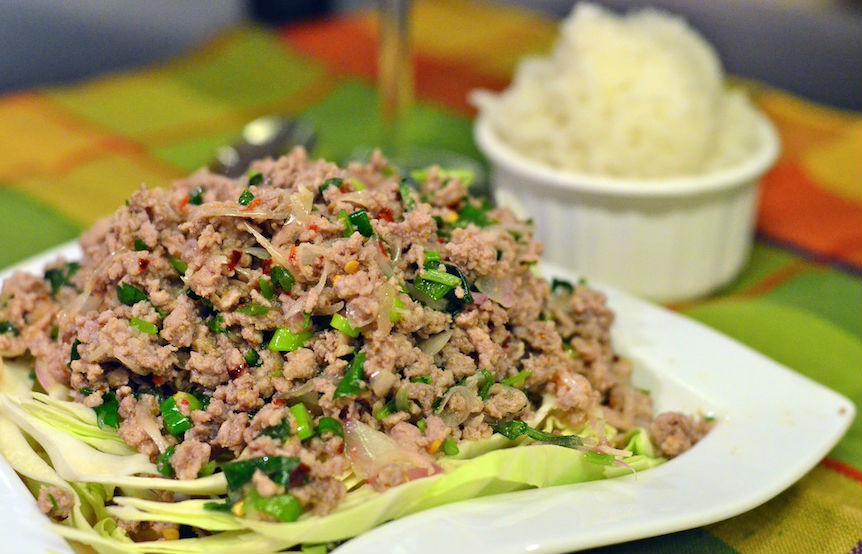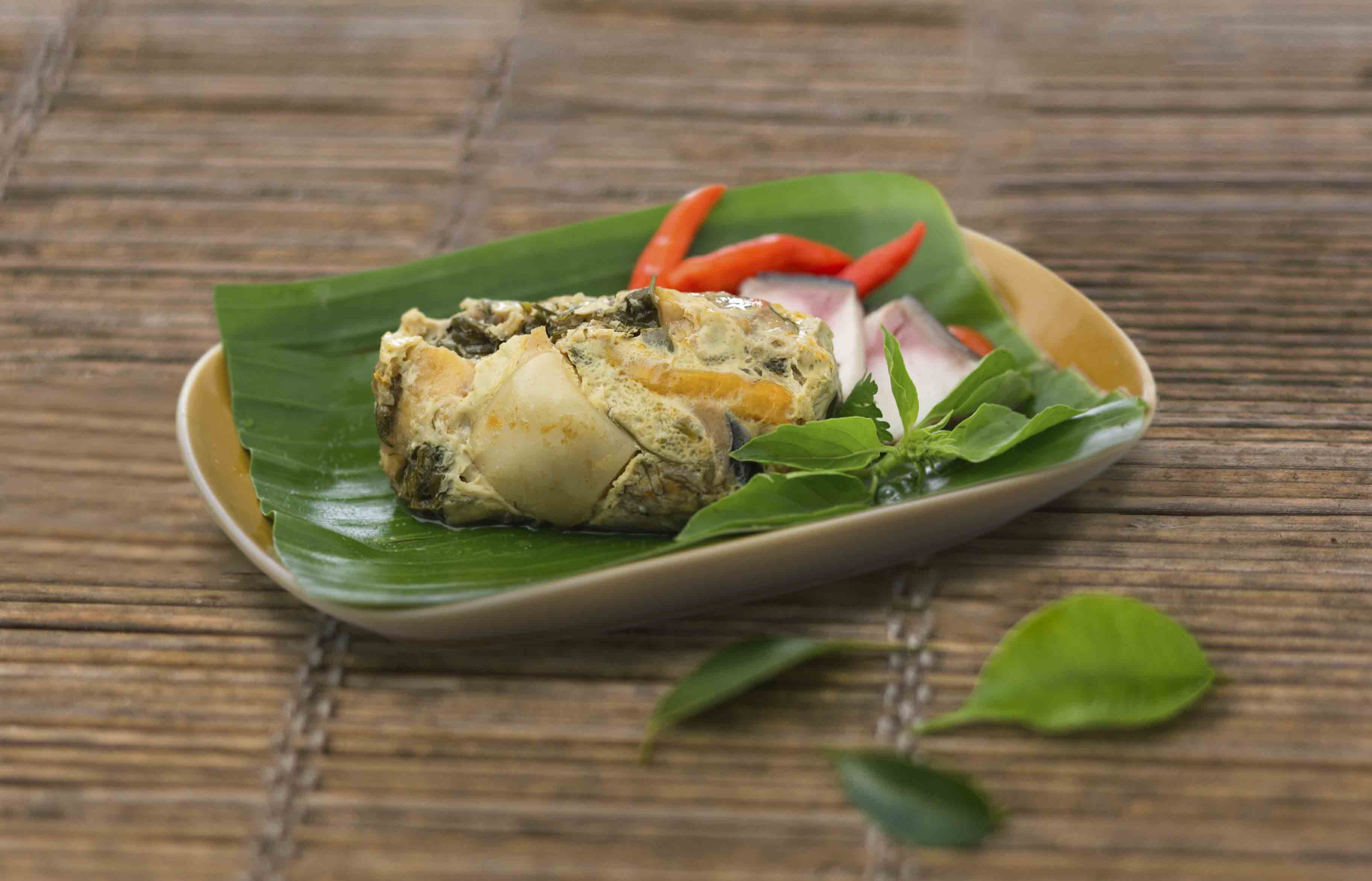Content []
Laos specialty dishes are remarkably diverse, both in ingredients and presentation. Traditional food of Laos offers a rich blend of flavors, ingredients, and cooking methods that reflect the country’s long-standing culture and way of life. Let’s explore the unique world of Lao traditional cuisine together!
Table of Contents
1. Key Characteristics of Laos Traditional Cuisine
One of the most distinctive features that makes Laos cuisine special lies not only in its flavors but also in the way food is prepared and shared, reflecting the deep cultural identity of the Lao people. A notable aspect of Lao dining is the use of sticky rice (khao niew) as the staple food. Unlike many Asian countries that primarily consume regular rice, sticky rice is a daily essential in most Lao meals. It is typically kept in woven bamboo baskets, and diners form small portions by hand to dip into sauces or enjoy with other dishes.
Laos cuisine is renowned for its bold and fresh flavors, made possible by the use of unique ingredients such as fermented fish sauce (padek), aromatic herbs like mint, lemongrass, and coriander, along with fresh chili, lime juice, and roasted ground rice. The harmonious blend of salty, sour, spicy, and bitter tastes results in dishes that are rustic yet incredibly enticing.
Meals in Laos are usually served family-style on a shared tray, with several small dishes placed in the center. This communal way of eating highlights the strong sense of togetherness in Lao culinary culture. Most Lao dishes are prepared by steaming, grilling, or served raw, with minimal use of stir-frying. This cooking style reflects a simple lifestyle that values health and balance in daily meals.
Additionally, fermentation plays a vital role in traditional Lao cuisine. From fermented fish and pickled vegetables to various dipping sauces, this method enhances the depth and richness of flavors, giving Lao food its distinctive and unforgettable character.
2. Must-Try Traditional Lao Dishes
2.1. Laap

Laap is considered a signature dish in Laos cuisine and is often served during festivals and family gatherings. It is also regarded as a symbol of good fortune and is commonly prepared as a gift during the New Year celebrations.
This dish is a type of meat salad made from grilled beef, chicken, or pork, mixed with fresh herbs, kaffir lime leaves, chili, and sesame oil. Laap can be enjoyed with fresh vegetables and pairs especially well with sticky rice.
2.2. Tam Mak Hoong
Tam Mak Hoong is a traditional Lao green papaya salad that is both refreshing and flavorful. It’s made with shredded green papaya, mixed with garlic, chili, peanuts, and a distinct Lao-style fermented fish sauce.
While it resembles Thailand’s Som Tum, the difference lies in the use of fermented fish sauce and a slightly different combination of ingredients. Tam Mak Hoong is known for its unique sour and spicy taste, usually served with steamed rice.
2.3. Sai Oua
Sai Ou - a traditional food of Laos is a flavorful sausage made from minced pork combined with a variety of herbs and spices such as galangal, kaffir lime leaves, shallots, coriander, chili, and fish sauce. Once marinated, the mixture is stuffed into casings and grilled over charcoal until it turns golden and releases a fragrant aroma.
With its rich, savory taste and distinctive herbal scent, Sai Oua is a beloved dish among both locals and visitors, often enjoyed on its own or paired with other traditional Lao foods.
2.4. Or Lam
Originating from the ancient capital of Luang Prabang, Or Lam is a hearty stew with a mildly spicy flavor. This dish usually includes meat, commonly beef or chicken, simmered together with eggplant, wild mushrooms, tofu, chili, lemongrass, basil, and a special local plant called Mai Sakaan that brings a distinctive peppery heat to the dish.
With its rich blend of herbs and vegetables, Or Lam represents the depth and warmth of traditional Lao home cooking.
2.5. Khao Poon
Khao Poon is a traditional spicy noodle soup that is highly popular in Laos, often served during festivals and family meals. The broth is simmered from chicken or pork bones, combined with aromatic herbs such as lemongrass, kaffir lime leaves, turmeric, garlic, chili, and fish sauce. The fine, soft rice noodles are generously ladled with the fragrant broth and served with fresh vegetables, bean sprouts, banana blossom, and herbs.
With its mildly spicy, tangy flavor and herbal aroma, Khao Poon delivers a well-balanced and rich taste. It is not only a common dish but also a symbol of warmth in Lao cuisine.
2.6. Mok Pa
Mok Pa is a signature Lao dish of steamed fish wrapped in banana leaves, showcasing the elegance of natural ingredient combinations. Fresh fish, typically tilapia or catfish, is marinated with lemongrass, kaffir lime leaves, chili, coriander, scallions, roasted rice powder, and padek.

Once mixed, the fish is tightly wrapped in banana leaves and steamed until cooked. When unwrapped, the fragrant steam reveals a delightful blend of herbs and spices. Mok Pa is usually enjoyed with sticky rice and boiled vegetables, making it an essential part of many Lao family meals.
2.7. Khao Jee
Khao Jee is the Lao version of the French baguette, influenced by colonial history but adapted with local flavors. The bread is toasted until crispy, split open, and spread with rich pâté, then filled with grilled meat, pork sausage, fresh herbs, cucumber, pickled carrots, and fresh chili. A spicy, savory sauce is drizzled over the filling to enhance the flavor.
Khao Jee is not only a convenient street food option but also a symbol of the East-meets-West culinary fusion in the daily life of Lao people.
2.8. Jeow Bong
Jeow Bong is a famous dipping sauce originating from Luang Prabang, known for its unforgettable flavor in Lao cuisine. It is made from roasted dried chilies, garlic, palm sugar, fermented fish sauce, and finely shredded dried buffalo skin. The combination of spicy heat, subtle sweetness, and chewy texture creates a bold and addictive condiment.
Jeow Bong is commonly eaten with sticky rice, boiled vegetables, or grilled meats, elevating the overall dining experience. It is also a popular souvenir for visitors to Laos.
2.9. Nam Khao
Nam Khao, also known as crispy rice salad, is a unique dish that offers both crunch and rich flavors. Cooked rice is seasoned, formed into balls, and deep-fried until crispy. These are then crumbled and mixed with fermented pork sausage (som moo), grated coconut, roasted peanuts, herbs, fried shallots, lime juice, and fish sauce. The dish stands out for its blend of tangy pork, creamy coconut and peanuts, and the crunchy texture of the rice.
Nam Khao is typically served with fresh greens and mint leaves, making it an ideal appetizer in traditional Lao feasts.
2.10. Khao Niew (Lao Sticky Rice)
Khao Niew also known as Lao sticky rice, is a staple in the daily life of the Lao people and is considered an essential part of their culinary culture. This dish is made from long, fragrant, and glutinous rice grains that are soaked overnight before being steamed in traditional bamboo baskets. When served, the sticky rice is often rolled into small balls to dip into sauces like Jeow Bong or eaten alongside grilled meats, boiled vegetables, or rich stews such as Or Lam.
Traditional food of Laos is a vivid reflection of the country’s cultural heritage, where each dish tells a story of community, nature, and balance. From sticky rice to hearty stews and zesty salads, each meal embodies simplicity and authenticity. Shared meals and bold flavors connect generations through taste and tradition.
Read this next
Quick Contact
WHAT DO CUSTOMERS SAY ABOUT US?
Look at the following reviews from our customers




